
Hook Head, historically called Rindowan, is a headland in County Wexford, Ireland, on the east side of the estuary of The Three Sisters. It is part of the Hook peninsula and is adjacent to the historic townland of Loftus Hall. It is situated on the R734 road, 50 kilometres (31 mi) from Wexford town.
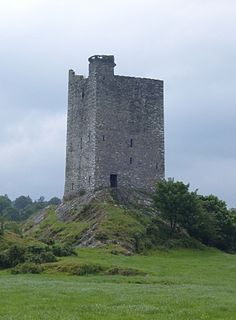
Carrigaphooca Castle, is a ruined five storey rectangular tower house situated on a steep-sided rock overlooking the River Sullane. It is located 6 km west of Macroom, County Cork, Ireland, in an area once known as Gleann na n-Dearg. The tower dominates the landscape of Lissacresig (Fairyland) in Clondrohid, and Lower Shanballyshane, in Kilnamartyra. Carrigaphooca is made of sandstone and limestone and was built as a defensive tower by MacCarthy clan member Donal MacCarthy of Drishane c. 1336-51.

Dunkerron Castle is a ruined four-storey tower house located in Templenoe, near Kenmare, County Kerry, in south-west Ireland. The castle was the family seat of the O'Sullivan Mór family from the late 16th century.

Carrignamuck Tower House, located in Carrignamuck townland, is a 15th century tower house located 2.8 km (1.7 mi) north of Coachford village and 2 km (1.2 mi) north-west of Dripsey village. It is also sometimes known as 'Dripsey Castle', a name latterly attributed to the 18th century house, Dripsey Castle, built nearby.
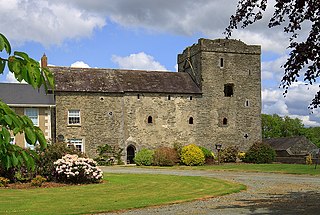
Athclare Castle is a Tudor tower house in the Dunleer area of County Louth in Ireland. Built in the 1550s, Athclare was built for the Barnewell family, and is typical of defensive architectural structures built in the Pale during the Tudor period in Ireland. Athclare has been extended and adapted in the centuries since its construction and is classified as a site of National social historical importance by the Irish National Inventory of Architectural Heritage.

Athlumney Castle is a tower house and fortified house and a National Monument in Navan, Ireland.

Coolhill Castle is a keep (donjon) and National Monument located in County Kilkenny, Ireland.
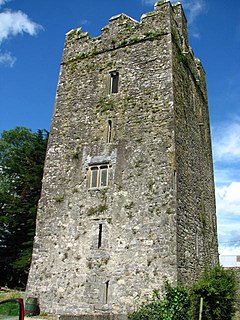
Clara Castle is a tower house (caiseal) located in County Kilkenny, Ireland.
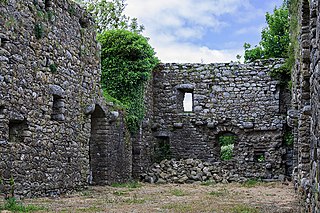
Rathumney Castle is a hall house and National Monument located in County Wexford, Ireland.

Rathmacknee Castle is a tower house and National Monument located in County Wexford, Ireland.
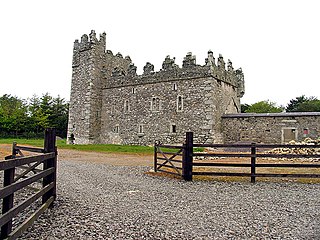
Coolhull Castle is a fortified house and National Monument located in County Wexford, Ireland.
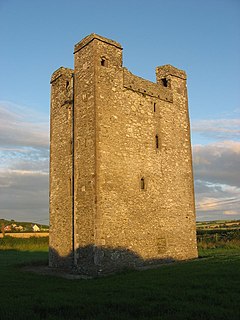
Roodstown Castle is a 15th-century tower house and National Monument located in County Louth, Ireland.

Roscrea Castle is a 13th-century motte castle in the town of Roscrea, Ireland. The Castle consists of a walled courtyard, gate block, and angled towers. Along with 18th century Damer House and gardens, the Castle forms part of Roscrea Heritage Centre.
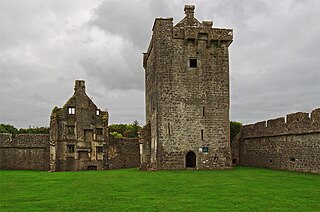
Pallas Castle is a tower house and National Monument located in County Galway, Ireland.
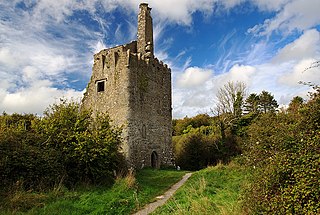
Dromore Castle is a tower house and National Monument located between the towns of Crusheen and Corofin in County Clare, Ireland.

Grallagh Castle is a tower house and National Monument located in County Tipperary, Ireland.
Isert Kelly Castle is a tower house and National Monument located in County Galway, Ireland.

Rahinnane Castle is a tower house and National Monument located in County Kerry, Ireland.
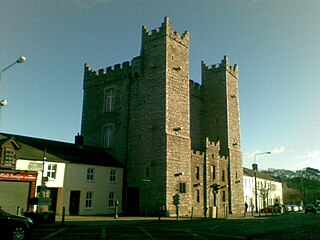
Ardee Castle also known as St. Leger's Castle, is a fortified medieval tower house in Ireland. Built in the 15th century, the castle was used as a prison during the 17th and 18th centuries and became Ardee's district courthouse until June 2006 when a specialised facility took its place. Ardee Castle is the largest fortified medieval Tower House in Ireland or Britain. The castle was originally built by Roger de Peppard in 1207, but not much is left from the original walls.

Slade is a small village and townland in County Wexford, Ireland. The townland, which has an area of approximately 1 square kilometre (0.4 sq mi), sits on the Hook Peninsula and had a population of 52 people as of the 2011 census. Slade has historically been a fishing port, and was defended by Slade Castle from the late 15th century. In the south of the townland, there is evidence of an earlier ringfort. The harbour in Slade village was extended in the mid-19th century and built upon piers dating from at least the 17th century. A salt-house was built here in the 17th century, to salt (preserve) the fish landed in the harbour. There is a small beach next to the harbour, and Hook Sub Aqua Club is based nearby.





















